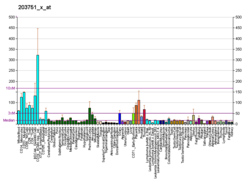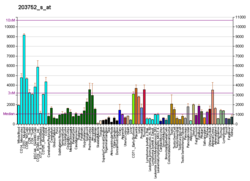Transcription factor JunD is a protein that in humans is encoded by the JUND gene.[5][6]
Function
The protein encoded by this intronless gene is a member of the JUN family, and a functional component of the AP1 transcription factor complex. It has been proposed to protect cells from p53-dependent senescence and apoptosis. Alternate translation initiation site usage results in the production of different isoforms.[7]
ΔJunD
The dominant negative mutant variant of JunD, known as ΔJunD or Delta JunD, is a potent antagonist of the ΔFosB transcript, as well as other forms of AP-1-mediated transcriptional activity.[8][9][10] In the nucleus accumbens, ΔJunD directly opposes many of the neurological changes that occur in addiction (i.e., those induced by ΔFosB).[9][10] ΔFosB inhibitors (drugs that oppose its action) may be an effective treatment for addiction and addictive disorders.[11] Being an unnatural genetic variant, deltaJunD has not been observed in humans.
Interactions
JunD has been shown to interact with ATF3,[12] MEN1,[13] DNA damage-inducible transcript 3[14] and BRCA1.[15]
See also
References
Further reading
External links
- JUND+protein,+human at the U.S. National Library of Medicine Medical Subject Headings (MeSH)
- FactorBook JunD
- PDBe-KB provides an overview of all the structure information available in the PDB for Human Transcription factor jun-D
This article incorporates text from the United States National Library of Medicine, which is in the public domain.







